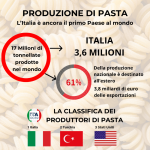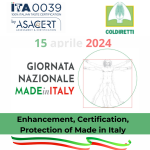Week of the Italian cuisine in the world 2022. ITA0039, the first certification in the world for the protection of the true Made in Italy in Italian the restaurant sector abroad, focuses on the impact of the Italian Sounding phenomenon on Italian food & beverage sales worldwide. Outside Italy, 6 out of 10 food products passed off as Made in Italy are actually pirated.
Italian Sounding covers 97% of pasta sauces, 94% of canned in oil and vinegar, 76% of canned tomatoes and 15% of cheeses.
The global impact of the phenomenon counts an estimated turnover of more than 120 billion euros per year (an increase of 70% in the last ten years), also increased by the Russian-Ukrainian war, which imposes restrictions and embargoes on trade.
Mapping Italian Sounding products in Europe and North America
The product categories most affected by the Italian Sounding phenomenon are dairy products, pasta, bakery products, meat products, condiments, confectionery products and ready meals (sauces, preserves, vinegar, oil, products in oil and vinegar, wine, liqueurs, etc.).
In 21 countries, in America and Europe, over 800 Italian Sounding products have been detected, also thanks to consumer reports on the free ITA0039 App. Overall, the category most affected by the phenomenon is that of confectionery products: 42% of the tarot products that recall those Made in Italy purchased in Europe and North America are ready and frozen dishes, sauces and preserves, products in oil and vinegar, condiments, coffee, etc. A quarter of the most imitated products are dairy products, followed by pasta, with a share of 16.1%.
Analyzing the individual areas, for the products of the confectionery, is recorded in Europe a level of online diffusion, if not even higher, than the general average: more than half of the Italian Sounding products purchased in the European markets in fact falls into this category (more than 55%). Different, however, the situation in the North American territory, where the confectionery slips into second place (with a quota on Italian imitation products equal to more than 25%), leaving the top of the podium to dairy products and dairy products, (more than one third of the Italian Sounding sold in the NAFTA area is more than 35%). In third place we find meat products (more than 17%), of which more than half represented by cold cuts (well over 50%).
Dairy products and dairy products
Dairy products are strongly affected by the Italian Sounding phenomenon, often linked, on some markets such as the United States, to the difficulty of finding the authentic product. In the NAFTA Area one of the foods (parmesan apart) to be most imitated is mozzarella, which is packaged with an evocative packaging of Italy but abnormal compared to the traditional methods of purchase, that is often sold in slices (as in Spain) or hermetically sealed scales (as in Belgium or France).
In some retail chains the reduction in the cost of the product compared to the original is around -68% for gorgonzola and -75% for provolone. Are frequent brands accompanied by indications such as ” Ricetta Italian Style” (Italian Style Recipe), Romano, or “sarvecchio” instead of “stravecchio”.
Dairy products rank third among the most imitated products in Europe, with a share of more than 16%, and of these far more than half (64%).
Products of the confectionery
One third of the imitation products belonging to this category are sauces used in the preparation of first courses, followed by frozen foods and ready meals (with a quota exceeding 22%) between lasagna, pasta salads, risotto and coffee (almost 10%, mainly in France and Switzerland and the USA).
Head to head in Europe with the department sauces and preserves for ready meals and frozen products, we find pizza (which represents 60% of the category), with different cripples such as the “pizza carbonara” detected in Spain, or pineapple pizza in Holland and Belgium.
Pasta
Pasta ranks third among the most imitated products globally, with a share that exceeds 16%. Tortellini, maccheroni and ravioli are the most common first courses in Europe, where they are the second most imitated product category, while in North America they occupy the fourth position.
However, the European market accounts for more than 70% of pasta exports worldwide. Today Germany is the first market for the export of Italian pasta, followed by Spain and Belgium.
Pasta, the queen of Made in Italy counterfeit, was also found in South America. Several names: “Tortellini tricolor”, “Raviolini” etc.
Meat products
Italian sounding products based on meat, ham, mortadella, cup, bacon, are more widespread in North America (with a share that exceeds 17%) and in Europe, where the share stops at about a little over half, 9%.
Among the most pirated regional products
Fontina Dop / Fontiago
Gorgonzola Dop / Zola, Combozola
Salame Milano / Milano Salama
Asiago Dop / Asiago Cheese
Prosciutto San Daniele Dop / San Daniele Prosciutto – Jambon Ham
Mortadella Bologna / Bologna, Mortadela
Aceto Balsamico di Modena Igp / Balsamic Winegar
Pecorino Romano Dop / Romano Cheeese
Mozzarella di Bufala Campana Dop / Fresh Buffalo Mozzarella
Salame Napoli / Salama Napoli
Defend with us the Italian cuisine in the world, all year round. Download the free ITA0039 app and become a sentinel of the true Made in Italy abroad!






